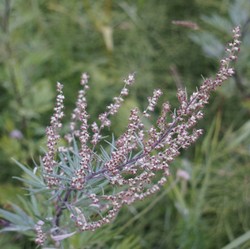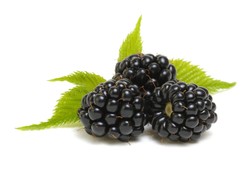I trust that few of us have enjoyed an ale flavoured with gruit. There are some ales in production which still use it, but it is a rare drink made for connoisseurs, but had you lived in Saxon England, gruit is what you would have got. So what is it?
Gruit [grut, gruyt] is a herbal mixture. There is no set recipe, and it is likely that the brewers used whatever was available to them at different times of year and in a variety of places. We need to be clear, ale was made in private homes, often by the wife of the household, and much depended upon what herbs were available to her. It was also brewed in institutions,such as monasteries, and in the large monasteries there were always herb gardens, so the task of the monastic herbalist was not always to make medicines, but to grow the herbs to flavour the monks' beer. If you look at Strabo's garden, the plot tended by Walafrid Strabo, a mediaeval abbot, there is artemisia, which is a herb widely used for flavouring ale, and Strabo was not growing that for nothing. In some large monasteries there would have been a special garden tended for the purpose of providing flavourants for the ale.
So what was in gruit? It was water flavoured with several or all of the following herbs:sweet gale [myrica or bog myrtle] , artemisia, yarrow [Achillea millefolium] ground ivy [hedera] , horehound [marrubium] and/or heather. The recipe involved soaking the herbs in warm water for several hours, depending upon the herb, until the water was flavoured to the brewer's satisfaction. It was then added to the must, the beer/ale mixture and drunk. Certain herbs have advantages as ale flavourants. Artemisia, the genus that includes wormwood, is the bitterest herb known to humans, and other members of this genus are bitter as well. The Saxons knew artemisia as mugwort. wort being a Saxon term for plant, the wort which goes in your mugs!
Heather is special. Its flowers make a delicate flavouring, but you need a pint of them and they have to be soaked overnight for twenty four hours, so I believe. I can imagine a misbehaving monk being given a penance of collecting a few pints of heather flowers. They make a lovely drink, but picking them is a long and arduous task. Of course the penance might involve going to pick bog myrtle, a muddy and chilly task at times.







 TheThousand Year Gardenon 11/26/2025
TheThousand Year Gardenon 11/26/2025
 Women of the Gospelson 10/11/2025
Women of the Gospelson 10/11/2025
 Religious Gardenson 08/25/2025
Religious Gardenson 08/25/2025
 Doctor of the Church: John Henry Newmanon 08/03/2025
Doctor of the Church: John Henry Newmanon 08/03/2025



Comments
The accumulation of lore passed down by word of mouth, often among women
The second paragraph to the first subheading, Gruit, advises us that "We need to be clear, ale was made in private homes, often by the wife of the household, and much depended upon what herbs were available to her."
How, when, where, who and why did the wife get all her ale-making knowledge from?
(Might ale-making -- ;-d -- have been part of her dowry?)
I have no knowledge about the precise resolution of this issue.
The John Derbyshire site describes G.K. Chesterton as having "favored fortified wines -- sherry and port."
The site does not indicate the source that furnishes its observation of the poet as drinking "a lot, though he seemed to hold it well." It elaborates that the poet ended a dispute by "accusing his opponent of being sober."
Online sources give no information about the above incident. Would there be information -- factual or folkloric -- on your, eastern-pond side as to the nature of that dispute won by calling the antangonist/defendant/opponent/plaintiff "sober" ;-D!?!
Ale and beer were traditionally associated with commoners, as was cider. Naturally some higher social orders drank it, but wine and spirits were associated with the u
Paper classes.
It's amusing to re-read this wizzley after having re-read your wizzley on Brexit. In the latter you mention The Secret People by G.K. Chesterton.
So I read the poem online through the John Derbyshire site. The latter says that "The common man's fondness for ale" runs through The Secret People.
The third-to-last line states that "It may be beer is best. / But we are the people of England; and we have not spoken yet. / Smile at us, pay us, pass us. But do not quite forget."
Would beer-drinking be associated with some other socioeconomic class on your, eastern-pond side?
Without the widget the Guinness would be less fizzy. I don't think that you should let your sentients play with the widget, as it might be small enough to choke them if they play with it.
Recently, the grocery store where I shop had quite a markdown on Guinness, which I don't know and which I opted to try for the first time just before Lent. So I let myself be swayed by the very attractive prices and purchased an eight-pack of canned Guinness.
I sampled a can and kept hearing something moving on the bottom. Finally, I saw a little white ball after I managed to hack an opening into the top of the can, which, despite its mangling, still will be able to go into recycling.
Internet sources say that the little ball is a widget that keeps nitrifying the canned Guinness.
What would the flavoring in Guinness taste like if it didn't have that ball, which is absent from the bottled four-packs that I see on the shelves?
Would this ball not be something that I can let my sentient kittens and cats play with?
I must confess that I hardly ever drink gin, so it is hard for me to express a preference. The link to Portugal is interesting, as Portugal is England' oldest ally and there have been longstanding cultural and trading relationships between the two countries.
If anyone knows the answer, it's Frank! Thank you!
Internet sources include an article, This Unique Gin Liquor is Flavored with Turnips, Berries and Herbs, by Laura McQuarrie July 15, 2016, on the Trendhunter site. McQuarrie indicates that Ginabo is now the world's only gin flavored with turnips. But she links turnip-flavored gin to Portugal!
This makes me try to imagine how gin and tonic would taste if the former were turnip-flavored, not juniper berry-flavored.
Which would you prefer, gin with juniper, surplus grain (what kind?) or turnips?